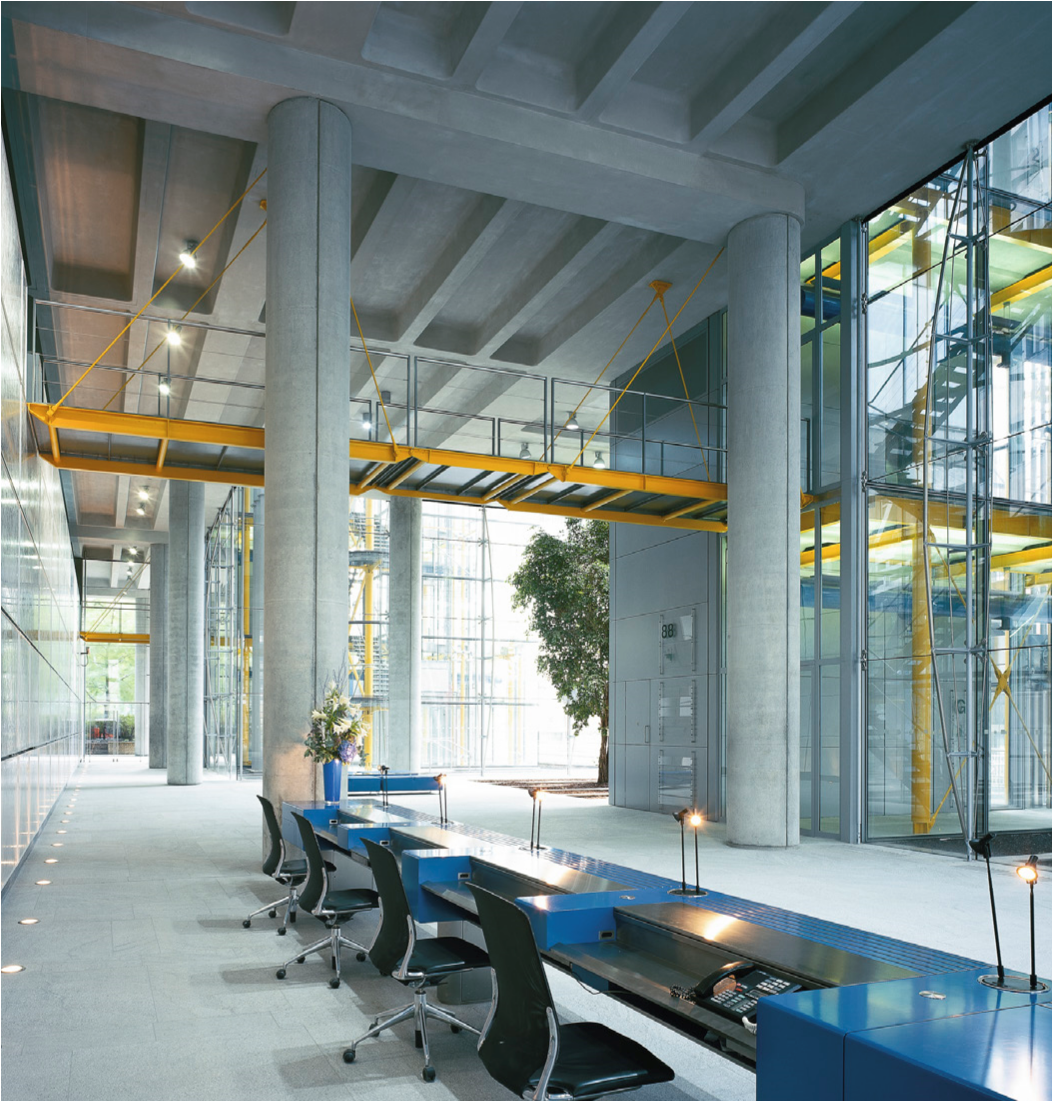88 Wood Street
“With its unapologetic modern facade, the building combines a jagged profile in an elegant concrete frame ... oozing an airy spirit full of honesty but not lacking in bravado.” Don Barker, Architecture Week
88 Wood Street demonstrates the potential for speculative commercial development that does not compromise on quality and enhances the public domain.
The site was formerly occupied by a 1920s telephone exchange – delays in securing the demolition of this building, combined with the onset of an economic recession in the 1990s, led to the cancellation of a scheme for a prestige banking headquarters. A larger scheme was designed in 1993–94, with speculative letting in mind.
This building is arranged as three linked blocks of office accommodation that step up from eight storeys on Wood Street, where the context includes two listed buildings, to 14 and finally 18 storeys to the west, responding to the taller built topography towards London Wall. The connections between blocks provides a very large floor area that can be easily subdivided. By using the extensive basement of the telephone exchange for the building plant, roof levels are kept largely free.
The office wings are constructed of in-situ concrete, contrasting with the lightweight, steel-framed service towers. The use of brilliant colour enhances their impact – air intakes and extracts at street level are also brightly coloured, contrasting with the neutrality of the occupied floors. The façades of the main office floors are glazed from floor to ceiling to maximise daylight and views – in addition, levels 8,12 and 16 lead directly onto roof terraces with spectacular views over the City.
Though built to a strict commercial budget, 88 Wood Street contains many innovative elements. Its triple-glazed façade is formed of single panels of highly transparent float glass. The inner faces of the external panes have a low emissivity coating which further reduces solar gain, while the cavity between the double glazed units and the third panel is fitted with motorised, integral horizontal blinds with perforated slats. Photocells on the roof monitor light conditions and adjust the angle of the blinds, thus minimising glare, heat gain and energy consumption.
Project information:
- Place: London, UK
- Date: 1993—1999
- Client: Daiwa Europe Properties
- Cost: £52 million
- Area: 33,073m²
- Structural Engineer: Ove Arup & Partners
- Services Engineer: Ove Arup & Partners
- Quantity Surveyor: Gardiner & Theobald
- Project Manager: D J Williams & Associates Ltd
- Construction Manager: Laing Management Ltd
- Main Contractor: Kajima/Laing Management Joint Venture
- Fit-Out Contractor: Kajima/Hazama Joint Venture
- Landscape Architect: Edward Hutchison
Awards:
2002
- The American Institute of Architects London/UK Chapter
- Excellence in Design Award Winner
2000
- RIBA Award/Stirling Shortlist
- Civic Trust Award
- Royal Fine Art Commission Trust Award
- Royal Academy Summer Exhibition Bovis/Lend Lease
- Award for Best Architectural Exhibit
Click here to see the full job sheet.
--RSHP
[edit] Related articles on Designing Buildings Wiki
Featured articles and news
A threat to the creativity that makes London special.
How can digital twins boost profitability within construction?
A brief description of a smart construction dashboard, collecting as-built data, as a s site changes forming an accurate digital twin.
Unlocking surplus public defence land and more to speed up the delivery of housing.
The Planning and Infrastructure bill oulined
With reactions from IHBC and others on its potential impacts.
Farnborough College Unveils its Half-house for Sustainable Construction Training.
Spring Statement 2025 with reactions from industry
Confirming previously announced funding, and welfare changes amid adjusted growth forecast.
Scottish Government responds to Grenfell report
As fund for unsafe cladding assessments is launched.
CLC and BSR process map for HRB approvals
One of the initial outputs of their weekly BSR meetings.
Architects Academy at an insulation manufacturing facility
Programme of technical engagement for aspiring designers.
Building Safety Levy technical consultation response
Details of the planned levy now due in 2026.
Great British Energy install solar on school and NHS sites
200 schools and 200 NHS sites to get solar systems, as first project of the newly formed government initiative.
600 million for 60,000 more skilled construction workers
Announced by Treasury ahead of the Spring Statement.
The restoration of the novelist’s birthplace in Eastwood.
Life Critical Fire Safety External Wall System LCFS EWS
Breaking down what is meant by this now often used term.
PAC report on the Remediation of Dangerous Cladding
Recommendations on workforce, transparency, support, insurance, funding, fraud and mismanagement.
New towns, expanded settlements and housing delivery
Modular inquiry asks if new towns and expanded settlements are an effective means of delivering housing.

























